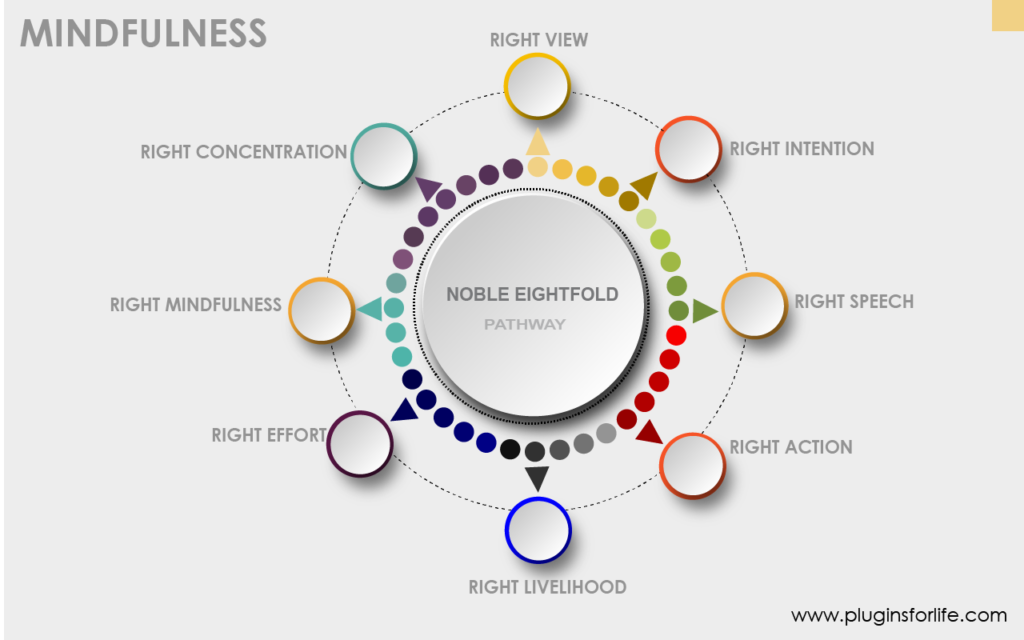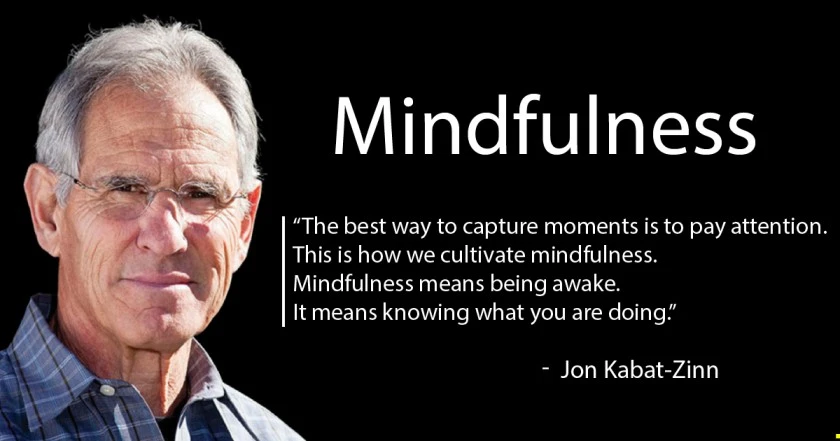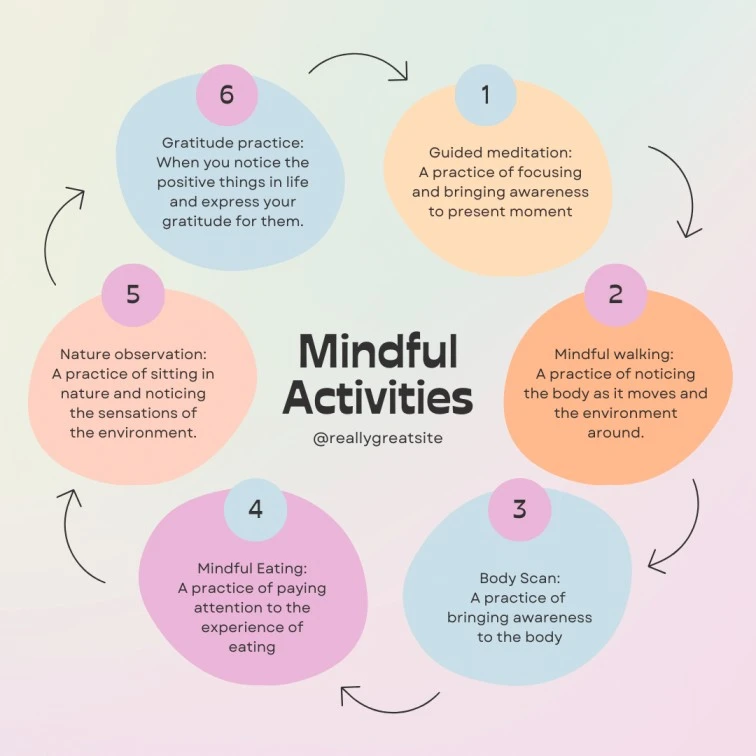Mindfulness is a mental state and conscious practice that involves paying focused and non-judgmental attention to the present moment. It involves being fully aware of your thoughts, feelings, sensations, and the environment around you without trying to change or react to them.
Mindfulness encourages individuals to embrace the here and now instead of dwelling on the past or worrying about the future .
Table of Contents
Origin of Mindfulness
The practice of Mindfulness is said to have its origins in ancient Buddhism – developed as a part of meditation practices .Surprising as it might seem the concept of such a deep concept of “mindfulness “ is found to have its impressions and practice – over 2,500 years ago !!
Origin of the word – Mindfulness
The term “mindfulness” comes from the Pali word “sati,” which is a central concept in Buddhist teachings.
“Pali” is an ancient Middle Indo-Aryan language that was used in the earliest Buddhist scripture .

Now “sati ” , an equivalent word for “mindfulness” In Pali Language , refers to mindfulness, awareness, or attention. It’s a term used extensively in Buddhist teachings, particularly in the context of meditation and mental cultivation.
Sati involves the practice of being fully present and aware of one’s thoughts, emotions, bodily sensations, and surroundings in the present moment.
Not to be confused with the long abolished tradition and ritual of “Sati Pratha”- It involved a widow self-immolating or being forced to self-immolate on her husband’s funeral pyre in certain communities/ cults/sects practicing Hinduism . The term “sati pratha” roughly translated would mean – the custom of virtuous women.
Coming back to Mindfulness – While practicing mindfulness meditation, practitioners develop “sati” by observing their thoughts and sensations without attachment or judgment. This practice aims to cultivate a clear awareness of the nature of the mind and reality, which can lead to insight and a deeper understanding of the impermanent and interconnected nature of existence.
“Sati” is also a key component of the Noble Eightfold Path, which is a central framework in Buddhist teachings for leading a life of ethical conduct and spiritual development. It’s often translated as “mindfulness,” but its meaning goes beyond just being aware. It encompasses a quality of attention that is clear, non-reactive, and all-encompassing.
Overall, “sati” in Pali is a term that encapsulates the practice of mindfulness as both a mental discipline and a way of being that fosters self-awareness, insight, and ultimately, liberation from suffering.
The Eightfold Path outlines a way of life that leads to the end of suffering and the attainment of enlightenment. It is often depicted as a wheel with eight spokes, symbolizing the interconnectedness of these aspects. Here are the eight components of the Noble Eightfold Path:

The Eightfold Path
- Right View (Samma Ditthi): This involves understanding the Four Noble Truths, the nature of suffering, the impermanence of life, and the law of cause and effect (karma).
- Right Intention (Samma Sankappa): This pertains to cultivating wholesome intentions and thoughts, including renunciation, compassion, and goodwill.
- Right Speech (Samma Vaca): This emphasizes speaking truthfully, avoiding harmful speech, gossip, and divisive language, and promoting speech that is helpful and kind.
- Right Action (Samma Kammanta): This involves engaging in actions that are morally upright and non-harming, such as refraining from killing, stealing, and harmful sexual behavior.
- Right Livelihood (Samma Ajiva): This refers to earning a living in ways that are honorable and do not cause harm to others or oneself. It discourages livelihoods associated with dishonesty, harm, or exploitation.
- Right Effort (Samma Vayama): This involves putting effort into cultivating wholesome qualities and letting go of unwholesome ones. It’s about maintaining a balanced and persistent effort in one’s spiritual practice.
- Right Mindfulness (Samma Sati): This is the practice of being fully present in each moment, observing thoughts, emotions, bodily sensations, and the surrounding environment with clear awareness and without judgment.
- Right Concentration (Samma Samadhi): This pertains to cultivating deep states of concentration and meditation that lead to insight, wisdom, and ultimately, the realization of the true nature of reality.
[Steps 1 + 2 = paññā / Wisdom]
[Steps 3 + 4 + 5 = sīla / Morality]
[Steps 6 + 7 + 8= samādhi / Concentration]
You will find the pathways taught in Buddhism somehow reflect with the great Aristotle who deduces that all ‘virtues’ lie in the mid- way between two extreme states- excess and deficiency.
For instance:
Courage is the mid – way expression between cowardice (deficiency) and recklessness (excess).
Confidence is the mid-way expression between self-deprecation (deficiency) and arrogance (excess).
Generosity is the mid- way between stinginess (deficiency) and profligacy (excess).
And the mid – path can only be achieved with mindfulness !!
In the 20th century, mindfulness gained broader recognition and popularity outside the realms of monastery, practitioners of well being and mental health , began to explore mindfulness as a secular technique for improving mental well-being and managing stress.
Kabat-Zinn – the great Mindfulness influencer

Kabat-Zinn – The man is best known for developing the Mindfulness-Based Stress Reduction (MBSR) program, which he introduced in 1979 at the University of Massachusetts Medical School. MBSR combines mindfulness meditation techniques with elements of yoga and emphasizes cultivating present-moment awareness, reducing stress, and enhancing overall well-being.
View one of Kabat-Zinn’s video here
Kabat-Zinn emphasizes that mindfulness is not a mental trick but a basic human inheritance that we are born and which is essential to life. He goes on to say that We need to be optimally aware of who we are, where we are, and how we are in order to survive individually and as communities, and even as an specie .
Often acknowledged as the father of modern mindfulness – Kabat-Zinn has authored several influential books on the subject, including :
- “Full Catastrophe Living: Using the Wisdom of Your Body and Mind to Face Stress, Pain, and Illness”
- “Wherever You Go, There You Are: Mindfulness Meditation in Everyday Life.”
Find a collection of quotes here Link
To attain mindfulness – a set of fundamentals have been derived which when adhered to are known to give the optimum results .
How to acheive Mindfulness – Pathways and alignment
- Present-Moment Awareness:
- Focus on the present moment.
- Engage fully with current experiences.
- Let go of past worries and future concerns.
- Non-Judgmental Observation:
- Observe experiences without judgment.
- Practice curiosity and acceptance.
- Avoid labeling things as good or bad.
- Acceptance and Non-Resistance:
- Acknowledge and accept things as they are.
- Cultivate openness to experience.
- Allow experiences to unfold naturally.
- Beginner’s Mind:
- Approach each moment with fresh eyes.
- Let go of preconceived notions.
- Embrace new experiences with openness.
- Awareness of Thoughts and Emotions:
- Observe thoughts, emotions, and sensations.
- Avoid getting entangled or reacting impulsively.
- Cultivating Compassion:
- Practice self-compassion and understanding.
- Extend compassion to others as well.
- Breath Awareness:
- Use the breath as an anchor.
- Focus on its sensations to center attention.
- Body Scan:
- Direct attention to body sensations.
- Notice tension without attempting to change it.
- Mindful Walking:
- Pay attention to step sensations and movement.
- Stay attuned to the environment.
- Mindful Eating:
- Fully engage in the eating experience.
- Savor each bite and enhance awareness.
- Mindful Listening:
- Listen attentively without interruption.
- Avoid pre-planning responses.
- Regular Practice:
- Engage in consistent mindfulness practice.
- Include formal meditation and daily mindfulness.
- Gratitude Meditation:
- Reflect on aspects you’re grateful for.
- Integrate gratitude into meditation practice.
- Gratitude Journaling:
- Write down daily expressions of gratitude.
- Cultivate a positive outlook and appreciation.
- Mindful Gratitude Walk:
- Focus on gratitude during mindful walks.
- Observe elements that evoke gratitude.
- Mindful Journaling:
- Use journaling for self-reflection.
- Write without judgment, exploring emotions.
- Self-Reflection:
- Journal insights from mindfulness practice.
- Reflect on challenges faced and progress.
- Emotional Release:
- Journal about feelings and concerns.
- Provide an outlet for emotional processing.
- Intentions and Goals:
- Set mindful intentions and goals.
- Use journaling to track progress.
- Gratitude Journal Section:
- Dedicate journal space to daily gratitude.
- Document moments of gratitude
7 Principles of Mindfulness
1. Non-judging
While practicing mindfulness try not to get caught up in ideas, opinions, likes, and dislikes and internal conflcits . If you notice your mind wandering away like a horse or jumping from thought to another like a monkey , then let it , but do not judge yourself for not paying attention, acknowledge your mind has wandered, and return your attention to your breath.
2. Patience
Be patient with yourself and be open to each moment. Take the time , take the pauses , get immersed in the activity .
3. Beginners mind
Be like an empty slate – do not let your past experiences , belief systems come in way of this new learning , let the new expereince overwrite the past .
4. Trust
Build trust on yourself , acknowledge your errors , look for inner guidence .
5. Non-striving
It’s likely that most of what you do in life, you do with a purpose or goal.
But, mindfulness involves “non-doing” and focusing on seeing and accepting things as they are in the present moment. Embrace the moment you are in, hold onto your awareness, and try not to react or transition into goal-setting mode.
6. Acceptance
Acceptance involves allowing things to be as they are without trying to change them. When you accept your current situation without wishing it was different or trying to change it, you’re able to be more aware of what you are experiencing at that moment.
7. Letting go
In your meditation practice, you may notice that as you start to pay attention to your inner experiences, you may discover your mind may want to hold onto specific thoughts or experiences.
Try and let your thoughts or experiences be what they are. Try not to get caught up in judging each experience. Just let it be and let it go.
Here are the top 10 benefits of practicing mindfulness:
- Stress Reduction: Mindfulness helps you manage stress by teaching you to respond to challenging situations with greater composure and awareness, reducing the negative impact of stress on your physical and mental health.
- Improved Emotional Regulation: By becoming more aware of your emotions and thought patterns, mindfulness enables you to respond to emotions in a more balanced and constructive manner, reducing impulsiveness and reactivity.
- Enhanced Focus and Concentration: Regular mindfulness practice can improve your ability to concentrate and stay focused on tasks, leading to increased productivity and better decision-making.
- Reduced Anxiety: Mindfulness helps lower anxiety levels by allowing you to observe anxious thoughts and feelings without getting consumed by them, creating a sense of distance and perspective.
- Better Relationships: Mindfulness promotes better interpersonal relationships by enhancing your capacity to listen attentively, communicate empathetically, and respond with understanding and compassion.
- Pain Management: Mindfulness can help manage chronic pain by changing the way you perceive pain sensations, improving your tolerance and reducing the emotional distress associated with pain.
- Enhanced Self-Awareness: Through mindfulness, you gain deeper insight into your thoughts, emotions, and behaviors, leading to greater self-awareness and personal growth.
- Increased Resilience: Mindfulness cultivates a mindset that is more adaptable and resilient in the face of challenges, allowing you to bounce back from setbacks with greater ease.
- Improved Sleep: Mindfulness practices, such as relaxation techniques and focused breathing, can improve sleep quality by reducing racing thoughts and promoting relaxation before bedtime.
- Greater Overall Well-Being: Regular mindfulness practice contributes to an overall sense of well-being, as it encourages you to live more fully in the present moment, appreciate life’s simple pleasures, and develop a positive perspective on life.
- It’s important to note that the benefits of mindfulness can be experienced over time with consistent practice. While these benefits are well-documented, individual experiences may vary, and it’s recommended to approach mindfulness with an open mind and realistic expectations.
- Here are some common challenges you might face while practicing mindfulness and some suggestions for how to address them:
- Restless Mind: One of the most common challenges is dealing with a restless or busy mind during meditation. Thoughts may keep popping up, making it difficult to stay focused.
- Solution: Acknowledge that a busy mind is normal. When thoughts arise, gently redirect your focus back to your chosen anchor, such as your breath or a mantra. Over time, your ability to maintain focus will improve.
- Impatience: Some individuals may become frustrated if they don’t experience immediate results. Mindfulness is a skill that develops gradually, and expecting instant changes can lead to disappointment.
- Solution: Cultivate patience and remind yourself that progress takes time. Celebrate small achievements and focus on the process rather than just the outcome.
- Physical Discomfort: Sitting or assuming a specific posture for meditation can lead to physical discomfort, such as pain in the back, legs, or joints.
- Solution: Find a comfortable position that works for you, whether it’s sitting in a chair, using cushions, or trying different postures. Adjust your position as needed during practice.
- Resistance to Emotions: Mindfulness can bring up challenging emotions or memories that you may be resistant to facing.
- Solution: Practice self-compassion. Emotions are a natural part of the human experience. Allow yourself to feel without judgment and seek support from a therapist if needed.
- Lack of Time: Finding time for mindfulness practice amidst a busy schedule can be challenging.
- Solution: Start with short sessions and gradually increase the duration. You can also integrate mindfulness into daily activities like walking, eating, or even breathing.
- Monotony: Some individuals may find the repetitive nature of mindfulness practices monotonous.
- Solution: Experiment with different mindfulness techniques to keep your practice fresh. You can try different forms of meditation, incorporate mindful movement, or practice in various settings.
- Resistance to Routine: Establishing a consistent mindfulness routine can be difficult, especially when life gets busy or unpredictable.
- Solution: Make mindfulness a priority by scheduling specific times for practice. Consider setting reminders or incorporating mindfulness into existing routines, like waking up or winding down.
- Judgment and Self-Criticism: Being non-judgmental is a core principle of mindfulness, but you might find yourself criticizing your own practice or progress.
- Solution: Treat yourself kindly and remind yourself that mindfulness is a journey. Focus on cultivating self-compassion and accepting your experience as it unfolds.
- Comparisons: You might compare your progress or experiences with others, which can create unnecessary pressure or feelings of inadequacy.
- Solution: Remember that mindfulness is a personal journey. Everyone’s experience is unique. Focus on your own growth rather than comparing yourself to others.
- Inconsistency: Maintaining a consistent mindfulness practice can be challenging over time.
- Solution: Set achievable goals and be flexible. If you miss a session, don’t be discouraged—simply return to your practice when you can.
- Facing these challenges is a natural part of the mindfulness journey. By acknowledging these obstacles and approaching them with patience and self-compassion, you can develop a more resilient and effective mindfulness practice. If you encounter persistent difficulties, seeking guidance from experienced mindfulness instructors or mental health professionals can also be beneficial.
Here is a selection of well-regarded books that cover various aspects of mindfulness practice, philosophy, and application:
List of Books around Mindfulness
- “The Miracle of Mindfulness” by Thich Nhat Hanh – A classic introduction to mindfulness by Zen master Thich Nhat Hanh, offering practical guidance and insights into incorporating mindfulness into everyday life.
- “Wherever You Go, There You Are” by Jon Kabat-Zinn -Written by the creator of Mindfulness-Based Stress Reduction (MBSR), this book explores mindfulness as a way of being, offering simple and profound insights.
- “The Power of Now” by Eckhart Tolle – Although not solely focused on mindfulness, this book explores the concept of being present and offers insights into transcending the ego and finding deeper consciousness.
- “Radical Acceptance” by Tara Brach – Tara Brach, a renowned mindfulness teacher, presents teachings and practices for self-compassion, self-acceptance, and emotional healing.
- “Mindfulness in Plain English” by Bhante Henepola Gunaratana – This book provides clear instructions on mindfulness meditation and explores Buddhist teachings related to mindfulness in a straightforward manner.
- “The Art of Happiness” by Dalai Lama and Howard Cutler = While not exclusively about mindfulness, this book explores the concept of happiness from a Buddhist perspective, touching on mindfulness practices.
- “The Headspace Guide to Meditation and Mindfulness” by Andy Puddicombe – Andy Puddicombe, the founder of the Headspace app, shares practical guidance and insights into meditation and mindfulness.
- “Real Happiness” by Sharon Salzberg – A comprehensive guide to mindfulness meditation, offering practical exercises, guided meditations, and insights from the perspective of a seasoned meditation teacher.
- “Mindfulness: An Eight-Week Plan for Finding Peace in a Frantic World” by Mark Williams and Danny Penman – This book offers an evidence-based eight-week mindfulness program with guided meditation practices and exercises.
- “Mindfulness for Beginners” by Jon Kabat-Zinn – Another book by Jon Kabat-Zinn, specifically aimed at beginners, offering clear explanations, guided practices, and insights into the transformative power of mindfulness.
List of Movies around Mindfulness
- “Peaceful Warrior” (2006) – Based on the book by Dan Millman, this film tells the story of a college gymnast who learns life lessons and mindfulness practices from a spiritual mentor after a life-altering accident.
- “Eat Pray Love” (2010) – Based on Elizabeth Gilbert’s memoir, this film follows the journey of a woman as she embarks on a global quest for self-discovery, exploring themes of meditation, mindfulness, and finding balance.
- “Into the Wild” (2007) – While not explicitly about mindfulness, this film depicts a young man’s journey to self-discovery through exploration of the natural world and interactions with various people. –
- “The Razor’s Edge” (1984) – Based on W. Somerset Maugham’s novel, this film follows the spiritual journey of a man who seeks deeper meaning in life and encounters different philosophies, including mindfulness.
- “Waking Life” (2001) – An animated film that delves into philosophical and existential questions, including discussions on consciousness, self-awareness, and the nature of reality.
- “Spring, Summer, Fall, Winter… and Spring” (2003) – A Korean film that unfolds over the course of several seasons, exploring the cycles of life and the practice of mindfulness within a Buddhist monastery.
- “Mindwalk” (1990) – A dialogue-driven film set in Mont Saint-Michel, France, where three characters discuss various philosophical and scientific ideas, including mindfulness and interconnectedness.
- “Kundun” (1997) hile not about mindfulness directly, this biographical drama follows the life of the 14th Dalai Lama and his journey of spiritual growth, which includes mindfulness practices.
- “The Secret Life of Walter Mitty” (2013) – This film portrays a man’s transformation from daydreamer to adventurer, incorporating themes of self-discovery and living in the present moment. –
- “Samsara” (2011) – Although it is a non-narrative documentary, “Samsara” explores the interconnectedness of humanity, nature, and the universe, encouraging viewers to contemplate their relationship with the world.
